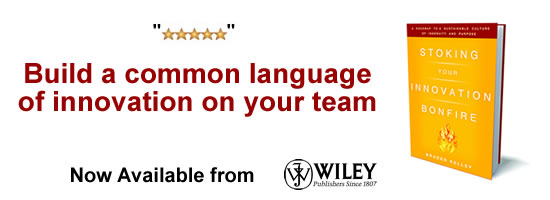Why Innovation Remains Elusive

Recently a reporter contacted me by email, asking several questions about innovation. I didn’t have the time to answer all of them, so I asked him what he really wanted to know. He replied that what he really wanted was a bottom line answer to the question of what makes the most difference in a company’s ability to innovate. As is my inclination, I reframe such questions to be about what isn’t there, versus what is.
Here’s what I wrote back:
If I think about why innovation is so elusive — the things that prevent a company from building deep innovation capability, it would come down to a half-dozen critical things that are interrelated:
1. Innovation identity crisis
Many companies struggle to identify what their innovative strength and style is. Are you a needs-based innovator, meaning you take a human-centered approach like good designers and design thinkers do? Or, are you more market-driven, meaning you’re an optimizing fast follower that takes a more capitalistic approach, exploiting the philosophy behind Christensen’s “innovator’s dilemma” by quickly copying and even improving on game-changing innovations as they hit the market? Or is your strength that of a technologist, like an Apple or Google, constantly on the edge of what’s achievable given technological advancement, be it yours or that of others?
If your organization simply doesn’t know or can’t easily conceptualize which of these categories it falls into, or should fall into, given its bench strength, you run the very expensive risk of “kitchen-sinking” innovation, scattering and squandering your attention and efforts.
2. Unclear innovation strategy
As the previous sentence implies, trying to be all things to all people just doesn’t work, and big outfits have a tough time articulating the answers to the essential questions of strategy: where will you play and how will you win? Like any strategy, innovation strategy is a question of focusing resources, which is something different (albeit a nuanced difference) than prioritization. It’s the ability to identify what you’re going to say NO to. Steve Jobs was great at this. He said he was always proudest of the thousands of things Apple said no to.
3. Inaccessible definition of innovation
When I speak to groups I ask them to show their hands if they consider themselves good problem solvers. All hands raise. I ask for a show of hands for the learners. All hands up. Then I ask the true innovators to raise their hands. Less than 5% raise their hands. It’s because people hear innovation and think: gizmo. Or app. Or code. Or product. Or service. Or feature. They think of innovation as a noun rather than a verb.
The best definition of innovation I’ve ever heard is by JetBlue’s founder David Neeleman: “Innovation is figuring how to do something better than it’s ever been done before.” Dirt simple, and it doesn’t matter if you’re a CEO or administrative assistant…you can innovate at some level (and there are a few).
Without the clear definition of what’s considered innovation, you can’t ask people to innovate and expect an intelligent response.
4. No common methodology
We’re not taught in school to innovate. Just the opposite. The natural curiosity we’re born with and utilize during our first 5 years of existence–which is all about observation, experimentation, and play–gets schooled out of us. We’re taught to get the right answer for the teacher. Then the right answer for the boss. We lose our natural born capacity to learn and create new knowledge.
So you have to unlearn the ways of business execution and reteach what came naturally: define a problem by observing or experiencing it, guessing how to solve it, creating a solution based on that guess, and quickly seeing if what you assumed might work actually does.
Without a common methodology, everything is ad hoc, hit or miss.
5. Methodology doesn’t feature experimentation
Beyond not having a common method, you’ll often find the de facto “innovation method” in reality being mostly an idea execution process, rather than a more scientific one. The mindset can’t be “I know what will work and I’m going to ensure it does.” It has to be “I think this may work so let me try it out.”
Scientists work on hypotheses, which is a fancy term for guesswork. If people aren’t getting their hands dirty out in the field with users and customers, testing early low-fidelity prototypes and adjusting a solution, they won’t be able to truly innovate.
For some reason, the hardest thing for those charged with innovation is to get out of the office, out of their data reports, and do what all good designers do, and what the Japanese call genchi genbutsu (go look, go see): mingle with customers and users and get real behavioral feedback when learning needs and testing concepts. (I’ve even heard senior executives go so far as advising employees to “ignore negative feedback from customers.”)
I learned how important it is to get out more and go face to face with customers while working with Toyota (which to this day stills runs over 1 million experiments a year companywide).
Look, innovation is an outside-in contact sport. If you want to grow something alone in a dark room, go farm mushrooms.
6. Mismatching talent to task
Companies love to move “high potential managers” into roles related to innovation. Bad move. Those folks are great at plans and budgets, aka convergent thinking. They’re great at execution. They’re great at growing lines of business. But what do you think they’re going to do when you move them into the messy and uncertain world of pursuing mysteries and creating something new which, in all likelihood, will fail? They’re going to try to plan, budget, execute, and obsess over revenue realization.
Innovation is about divergence, rapid prototyping, testing and failure. Larger, more mature companies have to figure out how to structure ways for innovative thinkers to break away from the main operation and get back to the metaphorical garage, with the charge being to solve a real problem and design a working prototype under a few intelligent constraints. (There are many such structures.. check out my recent article on Gremlin Groups). If you don’t, can’t or won’t, you’ll end up hiring an outside firm that’s set up to innovate for you. All you’ve done is outsource innovation and allow high potential managers to stay in their power zone of planning, budgeting, and executing.
That’s not necessarily a bad thing, it just doesn’t help your efforts to build innovation capability.
Reversing all of these elements is necessary to develop and sustain innovative capability. That’s why innovation sounds so simple but is yet so hard!
________
How about your organization…any of these symptoms getting in the way?
In my next article, I’ll introduce you to a powerful strategic innovation system that, when done right renders all of the above non-issues. It’s an embeddable approach that blends strategy, design thinking, and lean experimentation, as well as a go-to-market approach.
Wait! Before you go…
Choose how you want the latest innovation content delivered to you:
- Daily — RSS Feed — Email — Twitter — Facebook — Linkedin Today
- Weekly — Email Newsletter — Free Magazine — Linkedin Group
 Matthew E. May is the author, most recently, of Winning the Brain Game: Fixing the 7 Fatal Flaws of Thinking.
Matthew E. May is the author, most recently, of Winning the Brain Game: Fixing the 7 Fatal Flaws of Thinking.
NEVER MISS ANOTHER NEWSLETTER!
LATEST BLOGS
How To Stay Connected to Your Co-Workers as a Digital Nomad
The digital nomad lifestyle has grown dramatically in recent years. The number of digital nomads has increased by 42%…
Read MoreCarbon neutrality: what is it, how to achieve it and why you should care
When sustainability is on the agenda, you’re likely to hear many terms mentioned that you may or may not be…
Read More


